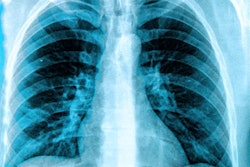
Rolling out a population-based CT lung cancer screening program across Europe would prevent 18,000 premature lung cancer deaths at a cost of 937 million euros, according to a budget impact analysis presented at the International Association for the Study of Lung Cancer (IASLC) 2022 World Conference on Lung Cancer on 7 August.
A first ever budget impact analysis of the Dutch-Belgian Randomized Lung Cancer Screening (NELSON) model demonstrates that it would prevent more than 18,000 premature lung cancer deaths across Europe at a cost of 937 million euros if half of the eligible population were screened, according to a report.
Data released in 2020 from the NELSON trial showed that CT lung screening confers a significant lung cancer mortality reduction for high-risk individuals (24% to 33%). Since then, discussions have centered around health economic evaluations of low-dose CT lung screening programs, according to the Netherlands-led research group that presented the analysis at IASLC 2022.
Their study estimated the financial impact and clinical outcomes using a budget impact model based on the NELSON study outcomes for a CT lung screening program that would be rolled out across 28 European countries.
"We ... developed a budget impact model to provide insights into absolute economic implications and clinical benefits," Xuanqi Pan, senior health economics and outcome research consultant at the Institute for DiagNostic Accuracy (iDNA) in the Netherlands, told AuntMinnieEurope.com. "We hope to convey that volume-based low-dose CT is both clinically and economically effective for European countries, with substantial health and economic benefits at a reasonable budget. Governments can now plan the actual budget they need for lung cancer screening implementation, even gradually over time, because our model is flexible and accommodates a yearly increasing screening uptake rate as well," noted Pan who presented the research at the conference on Sunday.
The NELSON study was a population-based, controlled trial that enrolled 15,792 individuals, who were randomized 1:1 to either the study arm or control arm. Study arm participants were offered CT screenings at baseline, one, three, and five and a half years after randomization. No screenings were offered to control arm participants.
Pan and her team applied their model based on the NELSON study to demonstrate the financial and health-related consequences of implementing a national lung cancer screening program for 28 European countries, compared to the current standard of care (no screening). In the model, the eligible population meeting NELSON inclusion criteria would undergo screening with volumetric nodule management. NELSON screening outcomes were also used in the model.
| Clinical outcomes and budget impact of volume CT lung cancer screening in Europe | |
| Parameters | N (50% screening rate) |
| Screening population | 20,997,108 |
| Premature lung cancer death averted | 18,169 |
| Budget impact (annual) | 937,321,529 euros |
| Incremental costs per premature lung cancer averted | 51,588 euros |
| Incremental costs per screening participant | 45 euros |
The model assumes that the screening population would amount to nearly 21 million individuals, with 50% of eligible individuals getting screened in Europe. With these assumptions, screening would prevent 18,169 premature lung cancer deaths averted at a budget impact of 937.3 million euros.
The incremental cost per premature lung cancer death averted was 51,588 euros, and the cost per screening participant was 45 euros. The sensitivity analysis showed that the most influential parameters affecting the total budget impact were the unit costs for CT scans, as well as treatment costs. Pan noted that the analysis did not include new technologies that could make screening more efficient, like artificial intelligence (AI) or liquid biopsy diagnostic tests.
"Although every life is priceless, healthcare resources are constrained, so maximizing gains out of the available budget is the key to optimizing the efficacy of healthcare systems," noted Pan, who is a PhD candidate at the University of Groningen researching the topic of health economic evaluation of lung cancer screening.
In absolute numbers, the budget impact of implementing a CT lung cancer screening program provides additional insights besides cost-effectiveness analysis, she added, stating that there are only a few studies reporting healthcare expenditures for screening implementation, and these have been conducted in the U.S.
 Xuanqi Pan
Xuanqi PanEurope versus the U.S.
Following the National Lung Screening Trial (NLST), one study indicated that CT screening would add $2 billion (1.97 billion euros) to the annual national healthcare expenditures and avoid up to 8,100 premature lung cancer deaths, at a screening uptake rate of 75%. Another study estimated the costs for a widespread CT screening program to be $2.5 billion (2.46 billion euros) at the same uptake rate (75%) based on the NLST screening outcomes, she noted.
"In our analysis, the prevention of more than 18,000 lung cancer deaths was achieved at a lower budget impact (approximately 937 million euros) in Europe, at an uptake of 50%. This is mainly explained by the improved efficacy of volume CT screening based on the NELSON screening outcomes and lower overall healthcare costs compared to the U.S. Thus, comparing it to earlier U.S. studies, we believe it is a reasonable price tag, especially when taking into account that it is a cost-effective use of a country's budget," Pan said.
The budget impact in the Dutch study was calculated by comparing the total costs of implementing a lung screening program to no screening situation. Premature lung cancer death prevented was calculated by applying the mortality reduction obtained from the NELSON study (24% for males and 33% for females at a 10-year follow up); then, the cost per premature lung cancer death was calculated by the total budget impact divided by total premature lung cancer deaths, resulting in a figure of 51,588 euros. This compares to a 2012 calculation for the NLST of $240,081 (236,222 euros) at 50% uptake rate and $242,074 (238,183 euros) at a 75% uptake rate,
A combination of multiple aspects accounts for the lower European budget, noted Pan, including different screening eligibility criteria, different lung cancer epidemiology, and the efficacy of screening based on the nodule management protocol. NELSON has a volumetric approach with a lower false-positive rate and lung cancer treatment costs, among others.
Future steps
Volume CT lung screening has the potential to address the heavy disease burden of lung cancer -- which accounted for 1.8 million deaths worldwide and nearly 400,000 deaths in Europe in 2020 -- through early detection, which then leads to a mortality reduction in high-risk populations. The researchers hope this study will help counter concerns that persist about the economic implications of implementing nationwide lung cancer screening programs.
The group also aims to adapt the budget impact model to other continents and is exploring the budget impact of using AI to assist in image reading for lung cancer screening programs, because the sensitivity analysis shows that one of the key drivers for the budget is the CT unit cost, and high-performance AI can help reduce it. Modeling the impact of blood-based biomarkers is another promising direction for future research, Pan said.



















